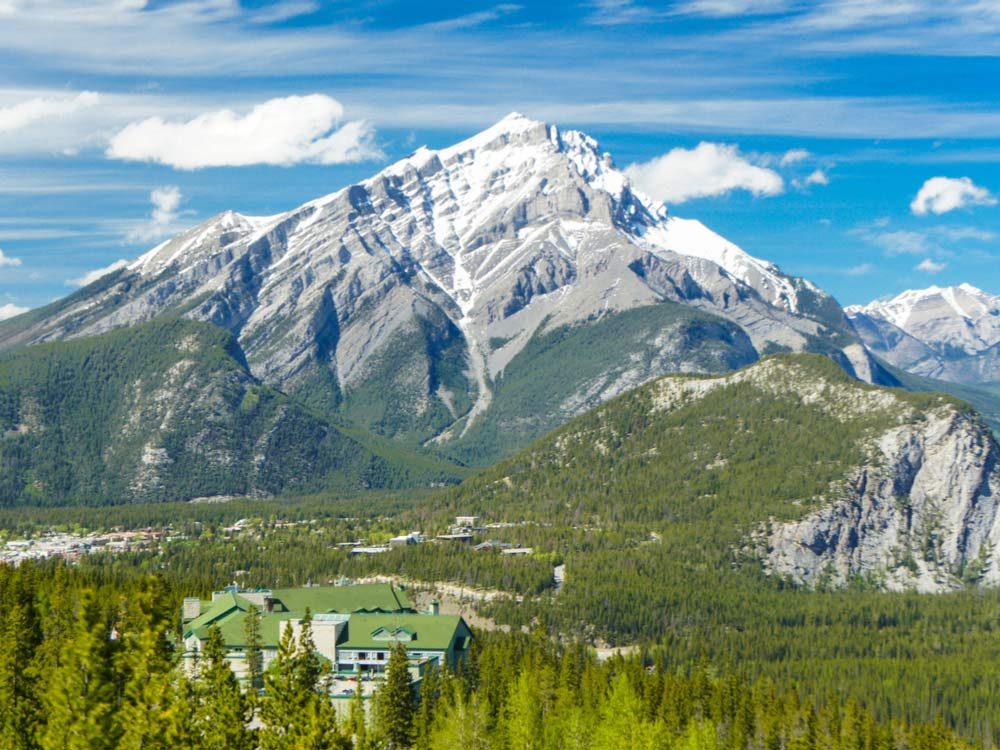
The Best Things to Do in Banff
Nestled in the crook of the Canadian Rockies 128 kilometres west of Calgary is the picturesque town of Banff, Alberta. Surrounded by what many consider the most spectacular scenery in North America, it was named after Canada’s first national park, in which it is a municipality. Now surrounded by five other parks—Glacier, Jasper, Yoho, Waterton Lakes and Mount Revelstoke—Banff National Park was declared a UNESCO World Heritage site in 1984.
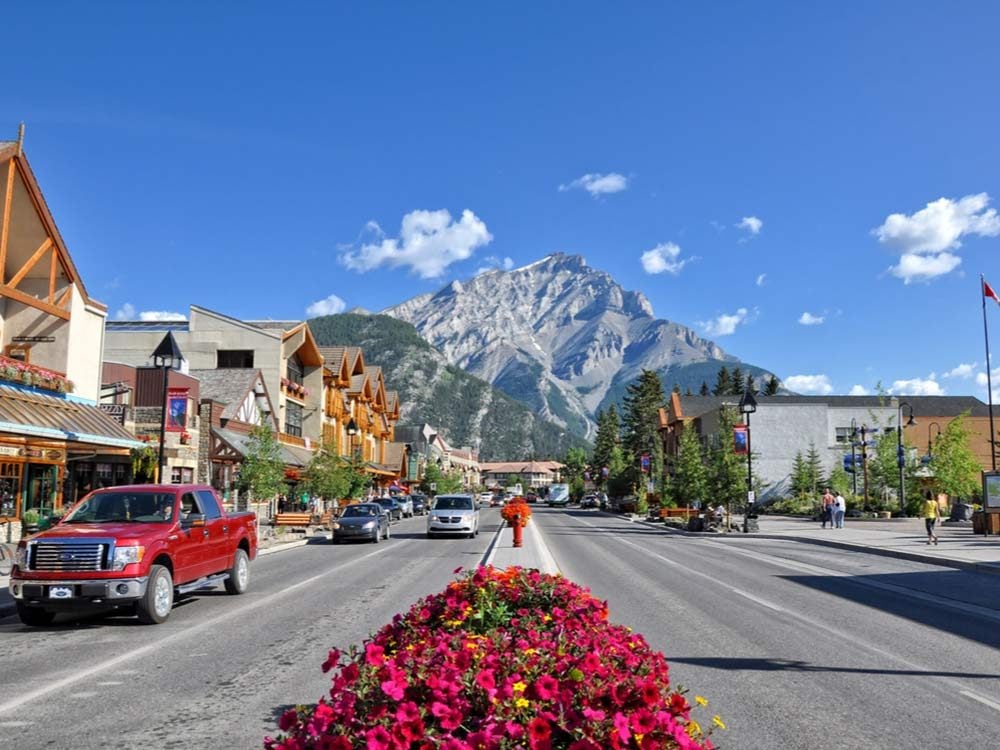
Explore the town of Banff
The town of Banff itself is small, but it packs a sensory wallop that will leave you breathless, with soaring mountain peaks encircling a quaint, alpine setting. Its main street bustles with shopping and restaurants. Many are locally-owned, brimming with Canadian-made art and photography. The food offerings are diverse, but they include homegrown favourites such as Alberta steak, bison and elk.
Check out 10 more Canadian dishes everyone needs to try at least once.
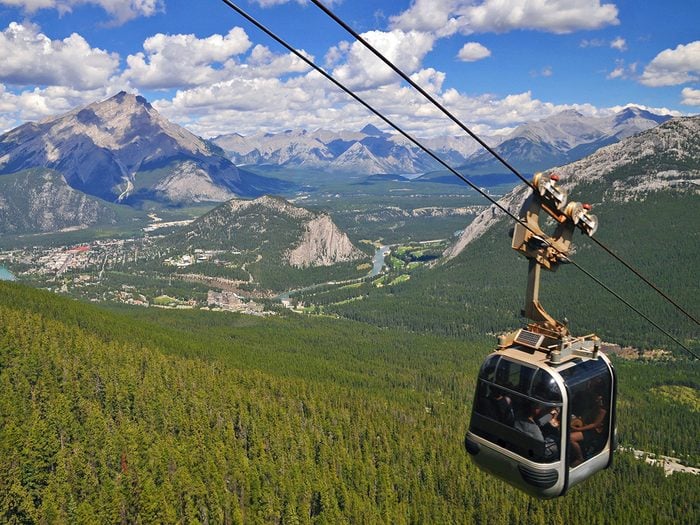
Ride the Banff Gondola
In combination with a business trip to Calgary, and because I had never been to Alberta, my husband Gabriel and I decided to spend four days exploring the Banff National Park area. Our quest to find the perfect view led us to the Banff Gondola at the base of Sulphur Mountain. The eight-minute journey in an enclosed cabin with windows brings you to the summit overlooking the town; the view is absolutely breathtaking.
As our second night in Banff coincided with our 22nd wedding anniversary, we were privileged to celebrate with the mountaintop dining experience at the Sky Bistro. After dinner, we sipped wine on comfortable leather couches and watched the waning sun glint off snowy peaks.
Find out what it’s like taking a luxury train trip through the Canadian Rockies.
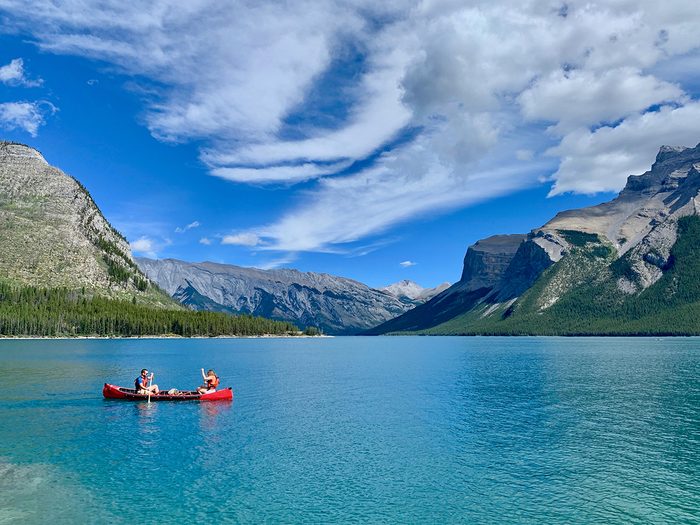
Cruise Lake Minnewanka
Lake Minnewanka, the largest lake in Banff National Park, is situated five kilometres northeast of the town. A lake cruise led us to catch sight of a pair of bald eagles nesting in the tall trees that rim the glacial lake. Our guide informed us that Canada boasts a much higher population of the species than the United States and conversely there are many more Canada geese in the States than in Canada. As we circled back, we saw the Devil’s Gap—the mountain gateway that marks the transition from the Rocky Mountains to the flatlands of the Prairies.
Don’t miss this awe-inspiring gallery of Canadian Rockies photography.
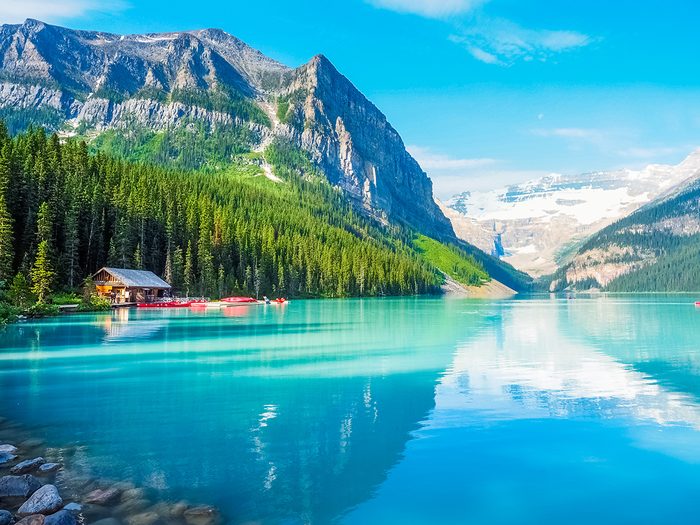
Marvel at Lake Louise
Lake Louise, named after Queen Victoria‘s fourth daughter, sits at the highest elevation of any community in Canada and lies a 40-minute drive from Banff. Anybody who has ever flipped through a scenic calendar has probably seen its ubiquitous image, featuring the Victoria Glacier in the centre. A picture does not do the glacial lake justice. Glimmering like a turquoise gem set among snow-capped peaks, Lake Louise exudes a certain tranquility that transcends a two-dimensional photo. Tourists stand quietly, in reverence of its natural beauty.
Like pilgrims before a shrine, we feel we are in the presence of something much greater than ourselves and are grateful for the experience. Following advice to take the longer but more scenic Highway 1A when travelling between Lake Louise and Banff proved fruitful. Gabriel pulled the car over to the side of the road at one point and I came within five feet of a mid-sized black bear. As I leaned out the window to snap a photo, the bear and I made eye contact. The smile never left my face the whole trip back to the hotel.
Don’t miss this roundup of unforgettable day trips from Calgary.
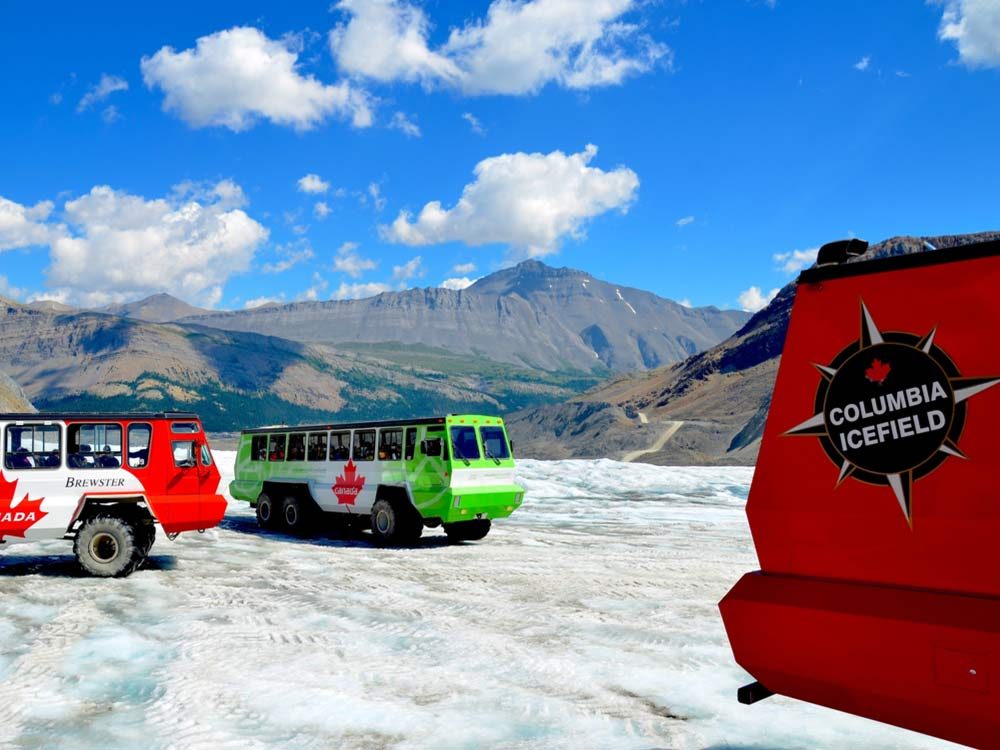
Explore the Columbia Icefield
Although the name sounds like an exotic cocktail, a “triple continental divide” is a rare geographical phenomenon. One of these rarities is situated in the Columbia Icefield at the southern tip of Jasper National Park. Water from its summit ultimately flows to three different oceans: the Atlantic, Pacific and Arctic. The area is also home to the Athabasca Glacier. (Here are more fascinating Canadian Rockies facts most people don’t know.)
A tour takes visitors onto the surface of the glacier using a massive vehicle especially designed for glacial travel. Upon setting foot onto the ancient ice, the stillness in the air is punctuated by the gurgling of water as it etches paths in the ice. A strategically placed water bottle allowed Gabriel a taste of pristine, undiluted glacier water.
The formation of glaciers occurs when more snow accumulates than melts. As snowflakes are compressed, they break down into a granular texture. The surface snow then refracts light in a way similar to how crystals embedded in ore glisten when touched by the sun. As I shielded my eyes from the glow, our guide explained the reason for the unique colour of glacial lake water. When glaciers move, they churn up silt into waterways. This silt, called “rock flour,” becomes suspended in water and the shortest ultraviolet waves-blue and green-bounce off the particles and cause the blue-green hue.
Put your geography skills to the test with our Canadian Rockies quiz.
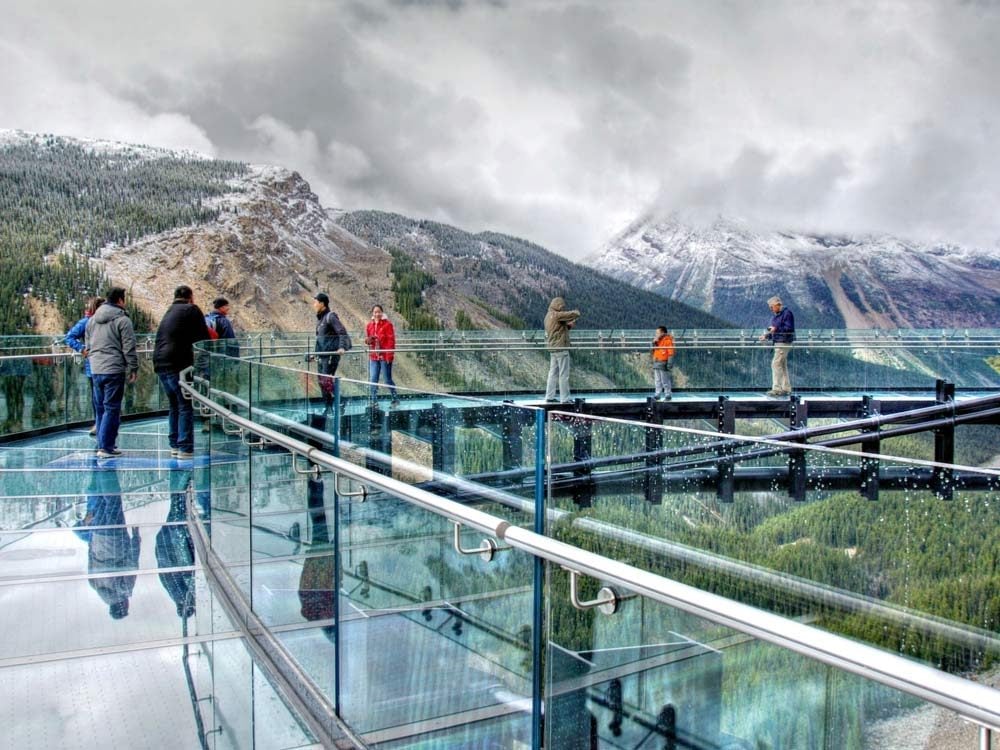
Venture onto the Columbia Icefield Skywalk
We capped off our icefield experience by visiting the Columbia Icefield Skywalk, an attraction that was then only a few months old. After exploring a cliff-edged walkway, visitors walk out onto a glass-floored observation platform suspended 280 metres over a glacier-formed valley. I walked with mincing steps, as the unprecedented view below my feet was intimidating. The shock to the vestibular system is immediate, but it subsides as you continue your walk. It was an adrenaline-spiking experience to say the least!
Got a head for heights? Don’t miss this breathtaking helicopter tour of the Rockies.
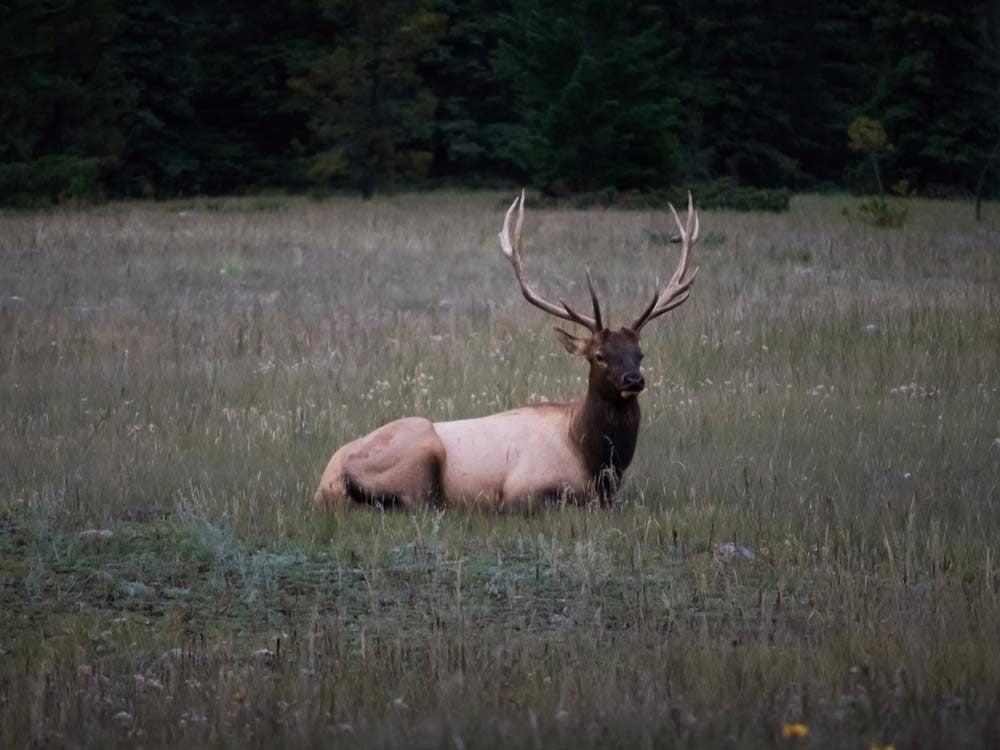
Watch for incredible wildlife
Driving along the highway, we passed numerous big-horned sheep and were lucky enough to come upon a caribou. These shy creatures, also known as reindeer, are unique because both genders sprout antlers. Feeding on brush and trees, covered in brown shaggy fur that turned white at its throat, the caribou turned and stared balefully at the humans watching it. The majestic antlers were covered in fine hairs and extended in a wide arc from its head. Having grown up with the National Film Board’s 60-second “Hinterland Who’s Who” public service announcements in the early ’70s, I was thrilled to come face to face with an animal I had heard so much about.
With the abundance of wildlife in the national parks, animal encounters are expected and guidelines provided. Although much of it is common sense, there are fines for feeding animals. They range from $300 for throwing a peanut to a Columbian ground squirrel (which looks like a husky chipmunk) to a whopping $25,000 for giving a honey bun to Winnie the Pooh!
The Banff National Park area offers a myriad of activities. From hiking scenic trails to browsing in local shops, there is something for everyone. Dip your toe in the frigid, turquoise waters of Lake Louise, then warm up with a visit to one of the many natural hot springs. Sample local delicacies and drink in the majestic mountain vistas. Feed your senses, your soul and your inner child, but whatever you do, never, ever feed the animals.
Now that you know the best things to do in Banff, find out the 10 places in Canada every Canadian needs to visit.